-
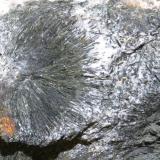 Aegirine
section: 5 x 5 cm
(entire piece: 13,5 x 9 x 3,5 cm - visible in Spanish FMF)
Being thin needles the green colour is clearly perceived, sometime Aegirine looks black ‚Äď but strike color will always be green.
This is the typical pyroxene of many different kind of alkaline rocks. (Author: kakov)
Aegirine
section: 5 x 5 cm
(entire piece: 13,5 x 9 x 3,5 cm - visible in Spanish FMF)
Being thin needles the green colour is clearly perceived, sometime Aegirine looks black ‚Äď but strike color will always be green.
This is the typical pyroxene of many different kind of alkaline rocks. (Author: kakov)
Aegirine section: 5 x 5 cm (entire
-
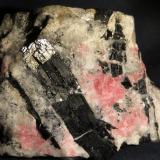 Arfvedsonite, Tugtupite, Albite
Ilímaussaq Intrusive Complex, Narsaq, Greenland
4,5 x 3,5 x 3 cm
Arfvedsonite is the typical amphibole of the intrusion. The best way to distinguish from Aegirine is through the strike colour that is more bluish for Arfvedsonite, while that of aegirine is clearly green-green. (Author: kakov)
Arfvedsonite, Tugtupite, Albite
Ilímaussaq Intrusive Complex, Narsaq, Greenland
4,5 x 3,5 x 3 cm
Arfvedsonite is the typical amphibole of the intrusion. The best way to distinguish from Aegirine is through the strike colour that is more bluish for Arfvedsonite, while that of aegirine is clearly green-green. (Author: kakov)
Arfvedsonite, Tugtupite, Albite Il
-
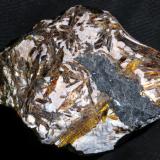 Astrophyllite, Aegirine
Khibiny Massif, Kola Peninsula, Russia
11 x 7 x 4,5 cm (Author: kakov)
Astrophyllite, Aegirine
Khibiny Massif, Kola Peninsula, Russia
11 x 7 x 4,5 cm (Author: kakov)
Astrophyllite, Aegirine Khibiny Ma
-
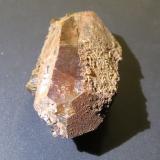 Baryte
Baryte
Uchquduq, Karakum Desert, Republic of Uzbekistan
45 x 20 x 17 mm; 44 grams (Author: kakov)Baryte
Uchquduq, Karakum Deser -
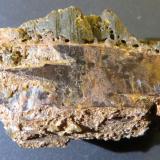 Baryte
Baryte
Uchquduq, Karakum Desert, Republic of Uzbekistan
45 x 20 x 17 mm; 44 grams (Author: kakov)Baryte
Uchquduq, Karakum Deser -
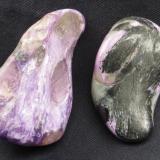 Charoite, Aegirine
Murun Alkaline Complex, Sakha, Yakutia, Siberia, Russia
6 x 4 x 3 cm & 5 x 3 x 1,5 cm (Author: kakov)
Charoite, Aegirine
Murun Alkaline Complex, Sakha, Yakutia, Siberia, Russia
6 x 4 x 3 cm & 5 x 3 x 1,5 cm (Author: kakov)
Charoite, Aegirine Murun Alkaline
-
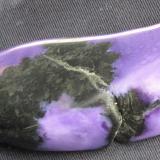 Charoite, Aegirine
Murun Alkaline Complex , Sakha, Yakutia, Siberia, Russia
10 x 3 x 3 cm (Author: kakov)
Charoite, Aegirine
Murun Alkaline Complex , Sakha, Yakutia, Siberia, Russia
10 x 3 x 3 cm (Author: kakov)
Charoite, Aegirine Murun Alkaline
-
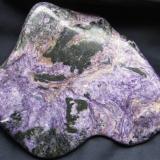 Charoite, Aegirine, Tinaksite
Murun Alkaline Complex , Sakha, Yakutia, Siberia, Russia
20 x 17 x 4 cm (Author: kakov)
Charoite, Aegirine, Tinaksite
Murun Alkaline Complex , Sakha, Yakutia, Siberia, Russia
20 x 17 x 4 cm (Author: kakov)
Charoite, Aegirine, Tinaksite Muru
-
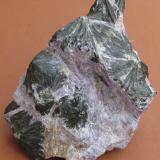 Charoite, Aegirine, Tinaksite
Murun alkaline complex , Sakha, Yakutia, Siberia, Russia
7 x 5 x 3 cm (Author: kakov)
Charoite, Aegirine, Tinaksite
Murun alkaline complex , Sakha, Yakutia, Siberia, Russia
7 x 5 x 3 cm (Author: kakov)
Charoite, Aegirine, Tinaksite Muru
-
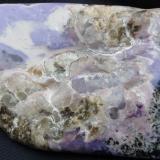 Charoitite (Charoite and associated minerals)
Murun Alkaline Complex , Sakha, Yakutia, Siberia, Russia
section: 12 x 6,5 cm (Author: kakov)
Charoitite (Charoite and associated minerals)
Murun Alkaline Complex , Sakha, Yakutia, Siberia, Russia
section: 12 x 6,5 cm (Author: kakov)
Charoitite (Charoite and associate
-
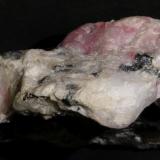 Chkalovite, Tugtupite
Ilímaussaq Intrusive Complex, Narsaq, Greenland
(section 10 x 4 cm)
Side view of the previous piece.
This capture shows the typical appearance of the beryllium silicate Chkalovite: it has a luster somewhat similar to fresh cheese. (Author: kakov)
Chkalovite, Tugtupite
Ilímaussaq Intrusive Complex, Narsaq, Greenland
(section 10 x 4 cm)
Side view of the previous piece.
This capture shows the typical appearance of the beryllium silicate Chkalovite: it has a luster somewhat similar to fresh cheese. (Author: kakov)
Chkalovite, Tugtupite Ilímaussaq I
-
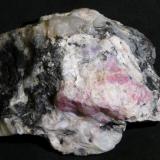 Chkalovite, Tugtupite, Sorensenite, Analcime, Aegirine
Ilímaussaq Intrusive Complex, Narsaq, Greenland
9 x 8 x 4 cm
The piece is slightly wet and it has been irradiated with SWUV right before the shot to enhance the visibility of Tugtupite.
This is a fragment of a hydrothermal vein with representation of typical silicates from the site; the first three are beryllium containing.
The Tugtupite here is secondary, it is formed through transformation of Chkalovite, hence it is not very pure nor deep in color, nevertheless it is strongly fluorescent under UV (LW and SW)
Sorensenite is the curved prisms on the border above of the big Tugtupite/Chkalovite grain.
Analcime appears as round grains on the top, while most of the dark areas in the piece are fine needles of Aegirine.
In the Ilímaussaq string of the Spanish FMF you can see photos of the same stone in dry state and the Tugtupite almost colorless after long time in the dark; in the same string there is also a LWUV photo of it. (Author: kakov)
Chkalovite, Tugtupite, Sorensenite, Analcime, Aegirine
Ilímaussaq Intrusive Complex, Narsaq, Greenland
9 x 8 x 4 cm
The piece is slightly wet and it has been irradiated with SWUV right before the shot to enhance the visibility of Tugtupite.
This is a fragment of a hydrothermal vein with representation of typical silicates from the site; the first three are beryllium containing.
The Tugtupite here is secondary, it is formed through transformation of Chkalovite, hence it is not very pure nor deep in color, nevertheless it is strongly fluorescent under UV (LW and SW)
Sorensenite is the curved prisms on the border above of the big Tugtupite/Chkalovite grain.
Analcime appears as round grains on the top, while most of the dark areas in the piece are fine needles of Aegirine.
In the Ilímaussaq string of the Spanish FMF you can see photos of the same stone in dry state and the Tugtupite almost colorless after long time in the dark; in the same string there is also a LWUV photo of it. (Author: kakov)
Chkalovite, Tugtupite, Sorensenite
-
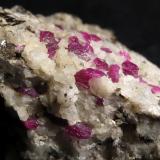 Corundum (Ruby)
Froland, Norway
FoV: 3 x 3 cm (Author: kakov)
Corundum (Ruby)
Froland, Norway
FoV: 3 x 3 cm (Author: kakov)
Corundum (Ruby) Froland, Norway Fo
-
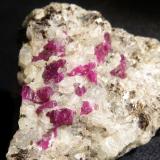 Corundum (Ruby)
Froland, Norway
FoV: 3 x 3 cm (Author: kakov)
Corundum (Ruby)
Froland, Norway
FoV: 3 x 3 cm (Author: kakov)
Corundum (Ruby) Froland, Norway Fo
-
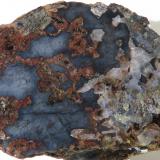 Cryolite (black), Fluorite (with Th), Siderite, Quartz, Galenite, Chalcopyrite
Cryolite (black), Fluorite (with Th), Siderite, Quartz, Galenite, Chalcopyrite
Ivigtut deposit, Ivittuut, Arsuk Fjord, Sermersooq, Greenland
FoV: 7 x 6 cm (Author: kakov)Cryolite (black), Fluorite (with Th), Siderite, Quartz, Galenite, Chalcopyrite
Ivigtut depo -
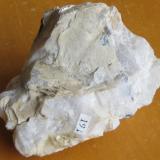 Epistolite, Ussingite
Ilímaussaq Intrusion, Narsaq, S-Greenland
7 x 5 x 3 cm (Author: kakov)
Epistolite, Ussingite
Ilímaussaq Intrusion, Narsaq, S-Greenland
7 x 5 x 3 cm (Author: kakov)
Epistolite, Ussingite Ilímaussaq I
-
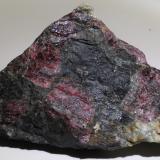 Eudialyte
Kola Peninsula, Rusia
9 x 6 x 4 cm
The other side of the same piece (with light matrix) on the previous photo.
This is one of the classic minerals of alkaline sites. It looks like garnet but have a completely different composition and structure, its hardness is also considerably lower than garnet. (Author: kakov)
Eudialyte
Kola Peninsula, Rusia
9 x 6 x 4 cm
The other side of the same piece (with light matrix) on the previous photo.
This is one of the classic minerals of alkaline sites. It looks like garnet but have a completely different composition and structure, its hardness is also considerably lower than garnet. (Author: kakov)
Eudialyte Kola Peninsula, Rusia 9
-
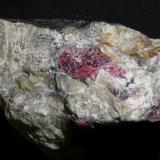 Eudialyte
Kola Peninsula, Rusia
9 x 6 x 4 cm
The other side of the same piece (with dark matrix) on the next photo.
This is one of the classic minerals of alkaline sites. It looks like garnet but have a completely different composition and structure, its hardness is also considerably lower than garnet. (Author: kakov)
Eudialyte
Kola Peninsula, Rusia
9 x 6 x 4 cm
The other side of the same piece (with dark matrix) on the next photo.
This is one of the classic minerals of alkaline sites. It looks like garnet but have a completely different composition and structure, its hardness is also considerably lower than garnet. (Author: kakov)
Eudialyte Kola Peninsula, Rusia 9
-
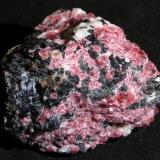 Eudialyte, Aegirine
Mont Saint-Hilaire, Canada
4,5 x 4 x 4 cm
Many of the minerals originally described from Ilímaussaq or the Kola complexes were later also reported from Mont Saint-Hilaire, although I have the impression that mostly in micros.
I highly recommend the album of Doug Merson here in the FMF where we have many gorgeous micros from there. (Author: kakov)
Eudialyte, Aegirine
Mont Saint-Hilaire, Canada
4,5 x 4 x 4 cm
Many of the minerals originally described from Ilímaussaq or the Kola complexes were later also reported from Mont Saint-Hilaire, although I have the impression that mostly in micros.
I highly recommend the album of Doug Merson here in the FMF where we have many gorgeous micros from there. (Author: kakov)
Eudialyte, Aegirine Mont Saint-Hil
-
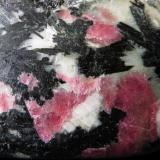 Eudialyte, Aegirine, Nepheline, Feldspar
Ilímaussaq Intrusive Complex, Narsaq, Greenland
FoV: 4 x 3,5 cm
polished
Nepheline is commented on the next pic (Author: kakov)
Eudialyte, Aegirine, Nepheline, Feldspar
Ilímaussaq Intrusive Complex, Narsaq, Greenland
FoV: 4 x 3,5 cm
polished
Nepheline is commented on the next pic (Author: kakov)
Eudialyte, Aegirine, Nepheline, Fe
-
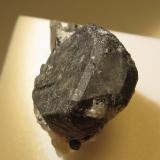 Eudialyte
Eudialyte
Eveslogchorr Mountain, Khibiny Massif, Kola Peninsula, Murmanskaja Oblast, Northern Region, Russia
crystal: 1,5 x 1,5 x 0,7 cm (Author: kakov)Eudialyte
Eveslogchorr Mountai -
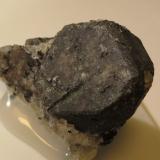 Eudialyte
Eudialyte
Eveslogchorr Mountain, Khibiny Massif, Kola Peninsula, Murmanskaja Oblast, Northern Region, Russia
crystal: 1,5 x 1,5 x 0,7 cm (Author: kakov)Eudialyte
Eveslogchorr Mountai -
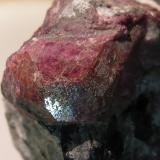 Eudialyte
Eudialyte
Ilímaussaq complex, Narsaq, Kujalleq, Greenland
FoV 2 x 2 cm (Author: kakov)Eudialyte
Ilímaussaq complex, -
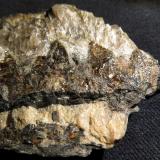 Fergusonite-(Y), Feldspar Biotite
Ytterby, Vaxholm, Sweden
FoV: 4 x 4 cm
One more ugly mineral that nevertheless is exciting.
First the exotic formula, it is a niobate of yttrium (YNbO4)
Then the locality is hardcore: It is a historical Swedish quarry that has delivered material for the discovery of 10 different rare earth elements - four of which have names derived directly from the place itself: Yttrium, Terbium, Erbium, Ytterbium
about the site: http://www.mindat.org/loc-3191.html (Author: kakov)
Fergusonite-(Y), Feldspar Biotite
Ytterby, Vaxholm, Sweden
FoV: 4 x 4 cm
One more ugly mineral that nevertheless is exciting.
First the exotic formula, it is a niobate of yttrium (YNbO4)
Then the locality is hardcore: It is a historical Swedish quarry that has delivered material for the discovery of 10 different rare earth elements - four of which have names derived directly from the place itself: Yttrium, Terbium, Erbium, Ytterbium
about the site: http://www.mindat.org/loc-3191.html (Author: kakov)
Fergusonite-(Y), Feldspar Biotite
-
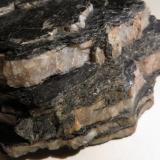 Gadolinite
Ytterby, Vaxholm, Sweden
FoV: 5 x 3 cm
Not a too good piece, but gadolinite from this historical Swedish quarry was the most important mineral for the discovery of most of the 10 different rare earth elements - four of which have names derived directly from the place itself: Yttrium, Terbium, Erbium, Ytterbium
the site: http://www.mindat.org/loc-3191.html (Author: kakov)
Gadolinite
Ytterby, Vaxholm, Sweden
FoV: 5 x 3 cm
Not a too good piece, but gadolinite from this historical Swedish quarry was the most important mineral for the discovery of most of the 10 different rare earth elements - four of which have names derived directly from the place itself: Yttrium, Terbium, Erbium, Ytterbium
the site: http://www.mindat.org/loc-3191.html (Author: kakov)
Gadolinite Ytterby, Vaxholm, Swede
-
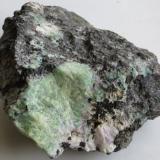 Green Sodalite, Steenstrupine-(Ce)
Ilímaussaq intrusion, Narsaq, S-Greenland
12 x 12 x 6 cm (Author: kakov)
Green Sodalite, Steenstrupine-(Ce)
Ilímaussaq intrusion, Narsaq, S-Greenland
12 x 12 x 6 cm (Author: kakov)
Green Sodalite, Steenstrupine-(Ce)
-
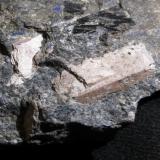 Murmanite
Peninsula Kola, (probably the Lovozero Massif), Russia
FoV= 4 x 3 cm;
crystal: 1,5 x 0,5 cm
MURMAINTE is a titanium and niobium containing sorosilicate, closely related in composition and structure with Epistolite and Vuonnemite, both of which are already pictured above in the this string.
On fresh surfaces the he color is more pinkish than here.
I would like to highlight the lustre of this mineral, subtle and difficult to describe, mindat calls it ‚Äúgreasy, pearly‚ÄĚ other sources use the wording ‚Äúsilverlike‚ÄĚ. Altogether this is a good reminder of the diversity of lustres in the mineral kingdom that we should experience directly and not only through the limited expressions for lustre in language.
As for the genesis, Murmanite belongs to a category of minerals that are not crystallized from melts or solutions, but form exclusively by transformation of other phases. (Khomyakov library(.)iem(.)ac(.)ru(/)exper(/)v10_1(/)49(.)pdf) (Author: kakov)
Murmanite
Peninsula Kola, (probably the Lovozero Massif), Russia
FoV= 4 x 3 cm;
crystal: 1,5 x 0,5 cm
MURMAINTE is a titanium and niobium containing sorosilicate, closely related in composition and structure with Epistolite and Vuonnemite, both of which are already pictured above in the this string.
On fresh surfaces the he color is more pinkish than here.
I would like to highlight the lustre of this mineral, subtle and difficult to describe, mindat calls it ‚Äúgreasy, pearly‚ÄĚ other sources use the wording ‚Äúsilverlike‚ÄĚ. Altogether this is a good reminder of the diversity of lustres in the mineral kingdom that we should experience directly and not only through the limited expressions for lustre in language.
As for the genesis, Murmanite belongs to a category of minerals that are not crystallized from melts or solutions, but form exclusively by transformation of other phases. (Khomyakov library(.)iem(.)ac(.)ru(/)exper(/)v10_1(/)49(.)pdf) (Author: kakov)
Murmanite Peninsula Kola, (probabl
-
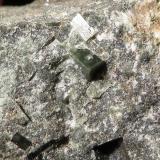 Narsarsukite
Island of Igdlutalik, Narsaq, South Greenland
FoV: 2,5 x 2 cm
GENERAL info about the mineral:
* Narsarsukite is a titanium containing chain silicate known currently from around 20 alkaline localities worldwide.
* General formula is Na2(Ti,Fe)Si4O11 - may contain F and OH
* Tetragonal crystal forms, mostly plates
* NOTE: Neptunite has almost identical formula but different crystal structure; it has monoclinic crystals.
* The type locality is Narsarsuk (xxx complex) from where the mineral was described by the Swedish mineralogist Flink in 19O1.
My previous photo of Narsarsukite from Ilímaussaq show a more typical aspect of the mineral, i.e. yellow plates.
The following is information about the PARTICULAR Igdlutalik Narsarsukite on this photo (source in the end):
The SITE :
* Igdlutalik is NOT inside, rather 12 km west of the Ilimaussaq complex. (and 45 km west of the type locality Narsarsuk)
* Narsarsukite occurs at the island within a dyke of peralkaline trachyte.
* The dyke was found during the 1 : 2o ooo reconnaissance mapping of the Julianehaab area by the Greenland Geological Survey.
* It is some 20 m wide and the outcrop can be traced not more than 50 m along the length of the dyke.
The CRYSTALS of Igdlutalik Narsarsukite:
* Short prisms (around twice as long as they are broad) unlike most narsarsukite from other locations that have tabular habits.
* Forms {1oo} and {oo1} are dominant
* The unique GREEN color here is probably due to aegirine inclusions. (the mineral itself is normally yellow)
COMPOSITION - particularities:
* The Igdlutalik narsarsukite has a distinctly high Ti/Fe ratio compared with those from Ilimaussaq and Narssarssuk; in this respect it most closely resembles the Sweet Grass, Montana narsarsukites (Stewart, 1959).
* Niobium is a significant minor component
FORMATION:
* All known occurrences of narsarsukite are in silica-oversaturated environments in close association with alkaline intrusive rocks that have crystallized at relative low pressures.
* Stewart (1959) pointed out that the requisite conditions for narsarsukite growth may be obtained where emanations from alkaline magmas react with siliceous wallrocks.
* Growth of narsarsukite, according to Stewart (I959), requires an excess of silica, high partial pressure of oxygen, and all abundance of Ti and Na. Stewart considered that at lower oxygen pressure neptunite, Na2FeTiSi4O12, would be generated. However, Rajasekaran (I966) demonstrated the apparently stable coexistence of narsarsukite and neptunite at St. Hilalre, Quebec.
SOURCE OF INFORMATION - most of the above is directly extracted from:
UPTON et. al. : Narsarsukite - a new occurrence in peralkaline trachyte, south Greenland
Mineralogical Magazine, Sept 1976, Vol. 40 PP. 737-46
www.minersoc.org/pages/Archive-MM/Volume_40/40-315-737.pdf
(giving all the references I have left in the above extracts)
on Mindat:
* Igdlutalik, the locality : http://www.mindat.org/loc-23311.html (by the way it is the type locality for Emeleusite)
* Narsarsukite crystals from the same dyke http://www.mindat.org/locentry-156911.html (Author: kakov)
Narsarsukite
Island of Igdlutalik, Narsaq, South Greenland
FoV: 2,5 x 2 cm
GENERAL info about the mineral:
* Narsarsukite is a titanium containing chain silicate known currently from around 20 alkaline localities worldwide.
* General formula is Na2(Ti,Fe)Si4O11 - may contain F and OH
* Tetragonal crystal forms, mostly plates
* NOTE: Neptunite has almost identical formula but different crystal structure; it has monoclinic crystals.
* The type locality is Narsarsuk (xxx complex) from where the mineral was described by the Swedish mineralogist Flink in 19O1.
My previous photo of Narsarsukite from Ilímaussaq show a more typical aspect of the mineral, i.e. yellow plates.
The following is information about the PARTICULAR Igdlutalik Narsarsukite on this photo (source in the end):
The SITE :
* Igdlutalik is NOT inside, rather 12 km west of the Ilimaussaq complex. (and 45 km west of the type locality Narsarsuk)
* Narsarsukite occurs at the island within a dyke of peralkaline trachyte.
* The dyke was found during the 1 : 2o ooo reconnaissance mapping of the Julianehaab area by the Greenland Geological Survey.
* It is some 20 m wide and the outcrop can be traced not more than 50 m along the length of the dyke.
The CRYSTALS of Igdlutalik Narsarsukite:
* Short prisms (around twice as long as they are broad) unlike most narsarsukite from other locations that have tabular habits.
* Forms {1oo} and {oo1} are dominant
* The unique GREEN color here is probably due to aegirine inclusions. (the mineral itself is normally yellow)
COMPOSITION - particularities:
* The Igdlutalik narsarsukite has a distinctly high Ti/Fe ratio compared with those from Ilimaussaq and Narssarssuk; in this respect it most closely resembles the Sweet Grass, Montana narsarsukites (Stewart, 1959).
* Niobium is a significant minor component
FORMATION:
* All known occurrences of narsarsukite are in silica-oversaturated environments in close association with alkaline intrusive rocks that have crystallized at relative low pressures.
* Stewart (1959) pointed out that the requisite conditions for narsarsukite growth may be obtained where emanations from alkaline magmas react with siliceous wallrocks.
* Growth of narsarsukite, according to Stewart (I959), requires an excess of silica, high partial pressure of oxygen, and all abundance of Ti and Na. Stewart considered that at lower oxygen pressure neptunite, Na2FeTiSi4O12, would be generated. However, Rajasekaran (I966) demonstrated the apparently stable coexistence of narsarsukite and neptunite at St. Hilalre, Quebec.
SOURCE OF INFORMATION - most of the above is directly extracted from:
UPTON et. al. : Narsarsukite - a new occurrence in peralkaline trachyte, south Greenland
Mineralogical Magazine, Sept 1976, Vol. 40 PP. 737-46
www.minersoc.org/pages/Archive-MM/Volume_40/40-315-737.pdf
(giving all the references I have left in the above extracts)
on Mindat:
* Igdlutalik, the locality : http://www.mindat.org/loc-23311.html (by the way it is the type locality for Emeleusite)
* Narsarsukite crystals from the same dyke http://www.mindat.org/locentry-156911.html (Author: kakov)
Narsarsukite Island of Igdlutalik,
-
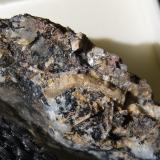 Narsarsukite, Manganoan Pectolite (black)
Kangerdluarsuk, Ilímaussaq Intrusive Complex, Narsaq, Greenland
FoV: 2,5 x 2 cm
GENERAL about the mineral:
* Narsarsukite is a titanium containing chain silicate known currently from around 20 alkaline localities worldwide.
* General formula is Na2(Ti,Fe)Si4O11 - may contain F and OH
* Tetragonal, seen mostly as tabular crystals, parallel to {oo1}.
* NOTE: Neptunite has almost identical formula but different crystal structure; it has monoclinic crystals.
* usually the color is YELLOW
* The type locality is the Narsarsuk pegmatite from where the mineral was described by the Swedish mineralogist Flink in 19O1.
Ilímaussaq Narsarsukite:
* First described from the Ilímaussaq complex by the Russian mineralogist Semenov in 1969
* Occurs in a quartz-bearing contact zone between naujaite and alkaline granite
* This environment is in accordance with:
* "Requisite conditions for narsarsukite growth may be obtained where emanations from alkaline magmas react with siliceous wallrocks" (Stewart (1959), quoted in UPTON et. al. 1977)
* The piece on this photo is from Kangerdluarsuk; where we are near the southern border of the Complex.
Turkestanite:
There are brown prisms (not very much darker than the narsarsukite) in the piece that is turkestanite (pointed out by a trustworthy source who had the piece in his hands). Not very well visible on this view, but there is the squared cross section of a crystal approx in the middle, above the left corner of the long narsarsukite plate. Other day I will try take and load close ups where it is better seen.
* "Ilimaussaq turkestanite forms up to a few millimeter large, brown or brownish-orange, idiomorphic, simple prismatic crystals; associated minerals are microcline, albite, augite, aegirine, quartz eudialyte and narsarsukite." (PETERSEN et.al 1999)
refs:
* STEWART 1959. Narsarsukite from Sage Creek, Sweet Grass Hills, Montana. Amer. Min. 44, 265-73.
(as quoted in: UPTON et. al. : Narsarsukite - a new occurrence in peralkaline trachyte, south Greenland - Mineralogical Magazine, Sept 1976, Vol. 40 PP. 737-46 www.minersoc.org/pages/Archive-MM/Volume_40/40-315-737.pdf)
* PETERSEN et.al: Turkestanite from the Ilímaussaq alkaline complex, South Greenland
Neues Jarhrbuch f√ľr Mineralogie - Monatshefte, issue: 9, 1999, pp: 424 - 432
(I did not manage to get the entire article, above sentence is quoted from the abstract) (Author: kakov)
Narsarsukite, Manganoan Pectolite (black)
Kangerdluarsuk, Ilímaussaq Intrusive Complex, Narsaq, Greenland
FoV: 2,5 x 2 cm
GENERAL about the mineral:
* Narsarsukite is a titanium containing chain silicate known currently from around 20 alkaline localities worldwide.
* General formula is Na2(Ti,Fe)Si4O11 - may contain F and OH
* Tetragonal, seen mostly as tabular crystals, parallel to {oo1}.
* NOTE: Neptunite has almost identical formula but different crystal structure; it has monoclinic crystals.
* usually the color is YELLOW
* The type locality is the Narsarsuk pegmatite from where the mineral was described by the Swedish mineralogist Flink in 19O1.
Ilímaussaq Narsarsukite:
* First described from the Ilímaussaq complex by the Russian mineralogist Semenov in 1969
* Occurs in a quartz-bearing contact zone between naujaite and alkaline granite
* This environment is in accordance with:
* "Requisite conditions for narsarsukite growth may be obtained where emanations from alkaline magmas react with siliceous wallrocks" (Stewart (1959), quoted in UPTON et. al. 1977)
* The piece on this photo is from Kangerdluarsuk; where we are near the southern border of the Complex.
Turkestanite:
There are brown prisms (not very much darker than the narsarsukite) in the piece that is turkestanite (pointed out by a trustworthy source who had the piece in his hands). Not very well visible on this view, but there is the squared cross section of a crystal approx in the middle, above the left corner of the long narsarsukite plate. Other day I will try take and load close ups where it is better seen.
* "Ilimaussaq turkestanite forms up to a few millimeter large, brown or brownish-orange, idiomorphic, simple prismatic crystals; associated minerals are microcline, albite, augite, aegirine, quartz eudialyte and narsarsukite." (PETERSEN et.al 1999)
refs:
* STEWART 1959. Narsarsukite from Sage Creek, Sweet Grass Hills, Montana. Amer. Min. 44, 265-73.
(as quoted in: UPTON et. al. : Narsarsukite - a new occurrence in peralkaline trachyte, south Greenland - Mineralogical Magazine, Sept 1976, Vol. 40 PP. 737-46 www.minersoc.org/pages/Archive-MM/Volume_40/40-315-737.pdf)
* PETERSEN et.al: Turkestanite from the Ilímaussaq alkaline complex, South Greenland
Neues Jarhrbuch f√ľr Mineralogie - Monatshefte, issue: 9, 1999, pp: 424 - 432
(I did not manage to get the entire article, above sentence is quoted from the abstract) (Author: kakov)
Narsarsukite, Manganoan Pectolite
-
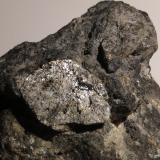 Naujakasite
Ilímaussaq Intrusive Complex, Narsaq, Greenland
FoV= 3 x 3 cm;
Crystal: 1.5 x 1.2 cm
NAUJAKASITE is by no means an aesthetic mineral but it is deeply exciting conceptually, let us see why:
This string begins with two pieces of Steenstrupine, a mineral found only few places and in low quantities outside the Ilímaussaq Intrusion. It has very complex structure and around 20 different elements in the full formula, many of which are rare ones.
The Naujakasite is similar in distribution, it is practically never found at all outside the Intrusion, even if inside it is locally very common, it reach to be the main component of a rock. But in opposition to Steentrupine, its formula is surprisingly simple: Na6(Fe,Mn)Al4Si8O26
Now, in case of ‚Äústrange combination of weird elements‚ÄĚ we somehow ‚Äúintuitively‚ÄĚ accept that the formation event has been a rare one with only one or very few known occurrences on Earth. Nevertheless seeing such a simple formula with few and common elements, the uniqueness of the Il√≠maussaq formation is somehow even more striking.
Strongly simplified, apart from the presence of many rare elements we are talking about a magma with very low concentrations of silicium (quarz is never found in most of the area in the central parts of the Intrusion!) and very high concentrations of sodium (Na) ‚Äď an element present in high amounts in many Il√≠maussaq minerals. (no wonder Sodalite has its type locality here‚Ķ) (Author: kakov)
Naujakasite
Ilímaussaq Intrusive Complex, Narsaq, Greenland
FoV= 3 x 3 cm;
Crystal: 1.5 x 1.2 cm
NAUJAKASITE is by no means an aesthetic mineral but it is deeply exciting conceptually, let us see why:
This string begins with two pieces of Steenstrupine, a mineral found only few places and in low quantities outside the Ilímaussaq Intrusion. It has very complex structure and around 20 different elements in the full formula, many of which are rare ones.
The Naujakasite is similar in distribution, it is practically never found at all outside the Intrusion, even if inside it is locally very common, it reach to be the main component of a rock. But in opposition to Steentrupine, its formula is surprisingly simple: Na6(Fe,Mn)Al4Si8O26
Now, in case of ‚Äústrange combination of weird elements‚ÄĚ we somehow ‚Äúintuitively‚ÄĚ accept that the formation event has been a rare one with only one or very few known occurrences on Earth. Nevertheless seeing such a simple formula with few and common elements, the uniqueness of the Il√≠maussaq formation is somehow even more striking.
Strongly simplified, apart from the presence of many rare elements we are talking about a magma with very low concentrations of silicium (quarz is never found in most of the area in the central parts of the Intrusion!) and very high concentrations of sodium (Na) ‚Äď an element present in high amounts in many Il√≠maussaq minerals. (no wonder Sodalite has its type locality here‚Ķ) (Author: kakov)
Naujakasite Ilímaussaq Intrusive C
-
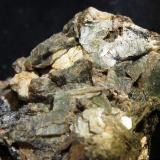 Naujakasite
Ilímaussaq Intrusive Complex, Narsaq, Greenland
FoV: 2,5 x 2 cm
A strange mineral that formed instead of nepheline in certain parts of the hyper-agpaitic magma (=low silica, high sodium) of the Ilímaussaq Intrusion. In spite of not containing any rare elements, it is practically not found anywhere else on Earth.
More info above my other Naujakasite photo that shows a single crystal. On this piece the colour is more fresh, greenish. (Author: kakov)
Naujakasite
Ilímaussaq Intrusive Complex, Narsaq, Greenland
FoV: 2,5 x 2 cm
A strange mineral that formed instead of nepheline in certain parts of the hyper-agpaitic magma (=low silica, high sodium) of the Ilímaussaq Intrusion. In spite of not containing any rare elements, it is practically not found anywhere else on Earth.
More info above my other Naujakasite photo that shows a single crystal. On this piece the colour is more fresh, greenish. (Author: kakov)
Naujakasite Ilímaussaq Intrusive C
-
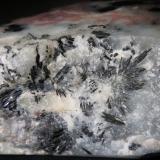 Nepheline (?), Aegirine
Ilímaussaq Intrusive Complex, Narsaq, Greenland
FoV: 5 x 4 cm
(side view of the piece on the previous photo)
Formation of Nepheline shows the lack of silicium in the magma.
It can be difficult to distinguish from feldspar, as it has similar colur and hardness, but it lack clear cleavage and has a somewhat greasy lustre - I am almost sure most of the gray substance we see here is nepheline. (in other areas of the same stone there is also a bit of feldspar, see previous pic) (Author: kakov)
Nepheline (?), Aegirine
Ilímaussaq Intrusive Complex, Narsaq, Greenland
FoV: 5 x 4 cm
(side view of the piece on the previous photo)
Formation of Nepheline shows the lack of silicium in the magma.
It can be difficult to distinguish from feldspar, as it has similar colur and hardness, but it lack clear cleavage and has a somewhat greasy lustre - I am almost sure most of the gray substance we see here is nepheline. (in other areas of the same stone there is also a bit of feldspar, see previous pic) (Author: kakov)
Nepheline (?), Aegirine Ilímaussaq
-
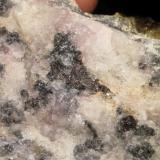 NEPTUNITE, Pyrochlore, Tugtupite
Ilímaussaq Intrusive Complex, Narsaq, Greenland
FoV: 4 x 5 cm (for reference you have the curvature of my finger on the top)
section of Neptunite crystal in right down corner: 3 x 3 mm
I have taken this piece for the relatively well developed Neptunite crystals (NB! this is not a micro photo), the Pyrochlore is more visible in the previous piece, here there are only small spots of it to the right of the central Neptunite area. The Tugtupite is also of very bad quality.
NEPTUNITE is a relatively common mineral in some rocks of the Ilímaussaq complex, among them the beryllium bearing hydrothermal veins. Hence if you have Tugtupite in your collection on a relatively decent sized matrix, it is highly probable you also will have Nepunite in it somewhere.
We are not talking about showy crystals like the well known wonders from San Benito, California, the grains/crystals here seldom get over a few mm and they are usually surrounded by other minerals. Nevertheless the Ilímaussaq Neptunite has some really interesting features, of which I would highlight:
1) It always shows the deep red colour.
2) Association: in the Tugtupite bearing hydrothermal veins the Neptunite grains are almost always directly associated with the niobium mineral Pyrochlore, that forms yellow or light brown irregular spots or oblong areas with a greasy lustre. Inside or near this substance we have dark grains, clearly deep red with a 10x loupe and often of romoidal shape ‚Äď this is the Neptunite!
3) Cultural aspects: Although the type locality is not Il√≠maussaq rather the Narsarsuk pegmatite located in the Igaliko intrusive complex, the two locations are relatively close to each other (and type locality Neptunite is practically impossible to get!). Furthermore we can say that the name given to the mineral is somehow equally justified at this site: In the Narsarsuk pegmatite there are big amounts of Aegirine, named after the sea god Aegir in the Nordic mythology ‚Äď this association inspired the usage of ‚ÄúNeptun‚ÄĚ, the Roman sea god in the nomenclature of the associated mineral. And well, Aegirine is also a common mineral in the Il√≠maussaq complex‚Ķ (Author: kakov)
NEPTUNITE, Pyrochlore, Tugtupite
Ilímaussaq Intrusive Complex, Narsaq, Greenland
FoV: 4 x 5 cm (for reference you have the curvature of my finger on the top)
section of Neptunite crystal in right down corner: 3 x 3 mm
I have taken this piece for the relatively well developed Neptunite crystals (NB! this is not a micro photo), the Pyrochlore is more visible in the previous piece, here there are only small spots of it to the right of the central Neptunite area. The Tugtupite is also of very bad quality.
NEPTUNITE is a relatively common mineral in some rocks of the Ilímaussaq complex, among them the beryllium bearing hydrothermal veins. Hence if you have Tugtupite in your collection on a relatively decent sized matrix, it is highly probable you also will have Nepunite in it somewhere.
We are not talking about showy crystals like the well known wonders from San Benito, California, the grains/crystals here seldom get over a few mm and they are usually surrounded by other minerals. Nevertheless the Ilímaussaq Neptunite has some really interesting features, of which I would highlight:
1) It always shows the deep red colour.
2) Association: in the Tugtupite bearing hydrothermal veins the Neptunite grains are almost always directly associated with the niobium mineral Pyrochlore, that forms yellow or light brown irregular spots or oblong areas with a greasy lustre. Inside or near this substance we have dark grains, clearly deep red with a 10x loupe and often of romoidal shape ‚Äď this is the Neptunite!
3) Cultural aspects: Although the type locality is not Il√≠maussaq rather the Narsarsuk pegmatite located in the Igaliko intrusive complex, the two locations are relatively close to each other (and type locality Neptunite is practically impossible to get!). Furthermore we can say that the name given to the mineral is somehow equally justified at this site: In the Narsarsuk pegmatite there are big amounts of Aegirine, named after the sea god Aegir in the Nordic mythology ‚Äď this association inspired the usage of ‚ÄúNeptun‚ÄĚ, the Roman sea god in the nomenclature of the associated mineral. And well, Aegirine is also a common mineral in the Il√≠maussaq complex‚Ķ (Author: kakov)
NEPTUNITE, Pyrochlore, Tugtupite I
-
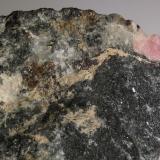 Pyrochlore, Neptunite, Tugtupite
Ilímaussaq Intrusive Complex, Narsaq, Greenland
FoV: 5 x 3 cm
Section from piece on previous photo.
Here the Pyrochlore is clearly visible as the greasy yellow irregular string and spots in the middle. There are deep red Neptunite grains inside, but this mineral is more clear on the piece of next pic
NEPTUNITE is a relatively common mineral in some rocks of the Ilímaussaq complex, among them the beryllium bearing hydrothermal veins. Hence if you have Tugtupite in your collection on a relatively decent sized matrix, it is highly probable you also will have Nepunite in it somewhere.
We are not talking about showy crystals like the well known wonders from San Benito, California, the grains/crystals here seldom get over a few mm and they are usually surrounded by other minerals. Nevertheless the Ilímaussaq Neptunite has some really interesting features, of which I would highlight:
1) It always shows the deep red colour.
2) Association: in the Tugtupite bearing hydrothermal veins the Neptunite grains are almost always directly associated with the niobium mineral Pyrochlore, that forms yellow or light brown irregular spots or oblong areas with a greasy lustre. Inside or near this substance we have dark grains, clearly deep red with a 10x loupe and often of romoidal shape ‚Äď this is the Neptunite!
3) Cultural aspects: Although the type locality is not Il√≠maussaq rather the Narsarsuk pegmatite located in the Igaliko intrusive complex, the two locations are relatively close to each other (and type locality Neptunite is practically impossible to get!). Furthermore we can say that the name given to the mineral is somehow equally justified at this site: In the Narsarsuk pegmatite there are big amounts of Aegirine, named after the sea god Aegir in the Nordic mythology ‚Äď this association inspired the usage of ‚ÄúNeptun‚ÄĚ, the Roman sea god in the nomenclature of the associated mineral. And well, Aegirine is also a common mineral in the Il√≠maussaq complex‚Ķ (Author: kakov)
Pyrochlore, Neptunite, Tugtupite
Ilímaussaq Intrusive Complex, Narsaq, Greenland
FoV: 5 x 3 cm
Section from piece on previous photo.
Here the Pyrochlore is clearly visible as the greasy yellow irregular string and spots in the middle. There are deep red Neptunite grains inside, but this mineral is more clear on the piece of next pic
NEPTUNITE is a relatively common mineral in some rocks of the Ilímaussaq complex, among them the beryllium bearing hydrothermal veins. Hence if you have Tugtupite in your collection on a relatively decent sized matrix, it is highly probable you also will have Nepunite in it somewhere.
We are not talking about showy crystals like the well known wonders from San Benito, California, the grains/crystals here seldom get over a few mm and they are usually surrounded by other minerals. Nevertheless the Ilímaussaq Neptunite has some really interesting features, of which I would highlight:
1) It always shows the deep red colour.
2) Association: in the Tugtupite bearing hydrothermal veins the Neptunite grains are almost always directly associated with the niobium mineral Pyrochlore, that forms yellow or light brown irregular spots or oblong areas with a greasy lustre. Inside or near this substance we have dark grains, clearly deep red with a 10x loupe and often of romoidal shape ‚Äď this is the Neptunite!
3) Cultural aspects: Although the type locality is not Il√≠maussaq rather the Narsarsuk pegmatite located in the Igaliko intrusive complex, the two locations are relatively close to each other (and type locality Neptunite is practically impossible to get!). Furthermore we can say that the name given to the mineral is somehow equally justified at this site: In the Narsarsuk pegmatite there are big amounts of Aegirine, named after the sea god Aegir in the Nordic mythology ‚Äď this association inspired the usage of ‚ÄúNeptun‚ÄĚ, the Roman sea god in the nomenclature of the associated mineral. And well, Aegirine is also a common mineral in the Il√≠maussaq complex‚Ķ (Author: kakov)
Pyrochlore, Neptunite, Tugtupite I
-
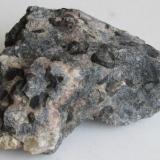 Steenstrupine-(Ce) in Lujavrite (name of the rock)
Kvanefjeld, Ilímaussaq intrusion, Narsaq, S-Greenland
6 x 4 x 2,5 cm (Author: kakov)
Steenstrupine-(Ce) in Lujavrite (name of the rock)
Kvanefjeld, Ilímaussaq intrusion, Narsaq, S-Greenland
6 x 4 x 2,5 cm (Author: kakov)
Steenstrupine-(Ce) in Lujavrite (n
-
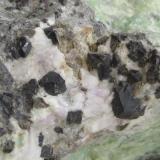 Steenstrupine-(Ce) xx
Ilímaussaq intrusion, Narsaq, S-Greenland
section from piece on the previous photo, crystals around 0,5 x 0,5 cm (Author: kakov)
Steenstrupine-(Ce) xx
Ilímaussaq intrusion, Narsaq, S-Greenland
section from piece on the previous photo, crystals around 0,5 x 0,5 cm (Author: kakov)
Steenstrupine-(Ce) xx Ilímaussaq
-
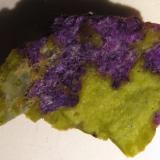 Stichtite in serpentine (lizardite?)
Stichtite in serpentine (lizardite?)
Dundas, Zeehan District, West Coast Council, Tasmania, Australia
3 x 2 x 0,7 cm (Author: kakov)Stichtite in serpentine (lizardite?)
Dundas, Zeehan District, West Coast Council, Tasmania, Au -
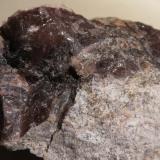 Thalenite-(Y), Tengerite-(Y)
Åskagens kvartsbrott, Värmland, Sweden
FoV: 3 x 3 cm
A silicate and a carbonate of Yttrium.
the site: http://www.mindat.org/loc-10006.html (Author: kakov)
Thalenite-(Y), Tengerite-(Y)
Åskagens kvartsbrott, Värmland, Sweden
FoV: 3 x 3 cm
A silicate and a carbonate of Yttrium.
the site: http://www.mindat.org/loc-10006.html (Author: kakov)
Thalenite-(Y), Tengerite-(Y) √Öskag
-
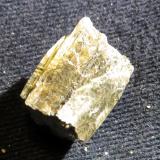 Thortveitite
Kabuland, Iveland, Norway
14 x 11 x 9 mm
A silicate of the rare element scandium
Found in 1989 by Frode Andersen.
Brought in June 1991 at the Koppaberg show (Sweden), an amazing event in the middle of a forest. (Author: kakov)
Thortveitite
Kabuland, Iveland, Norway
14 x 11 x 9 mm
A silicate of the rare element scandium
Found in 1989 by Frode Andersen.
Brought in June 1991 at the Koppaberg show (Sweden), an amazing event in the middle of a forest. (Author: kakov)
Thortveitite Kabuland, Iveland, No
-
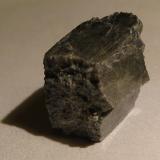 Thortveitite
Kabuland, Iveland, Norway
14 x 11 x 9 mm
A silicate of the rare element scandium
Found in 1989 by Frode Andersen.
Brought in June 1991 at the Koppaberg show (Sweden), an amazing event in the middle of a forest. (Author: kakov)
Thortveitite
Kabuland, Iveland, Norway
14 x 11 x 9 mm
A silicate of the rare element scandium
Found in 1989 by Frode Andersen.
Brought in June 1991 at the Koppaberg show (Sweden), an amazing event in the middle of a forest. (Author: kakov)
Thortveitite Kabuland, Iveland, No
-
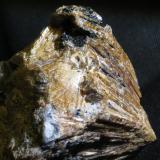 Titanite
Kola Peninsula, Russia
section: 5 x 5 cm
(entire piece: 7 x 5 x 4 cm - loaded in my album in the Spanish FMF)
Not a specifically alkaline mineral, but in a pretty unusual habit. (Author: kakov)
Titanite
Kola Peninsula, Russia
section: 5 x 5 cm
(entire piece: 7 x 5 x 4 cm - loaded in my album in the Spanish FMF)
Not a specifically alkaline mineral, but in a pretty unusual habit. (Author: kakov)
Titanite Kola Peninsula, Russia se
-
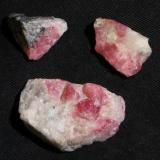 Tugtupite, Albite
Ilímaussaq Intrusive Complex, Narsaq, Greenland
max measurement: 3 cm
These pieces small but show relatively good quality Tugtupite. They are all dry and have NOT been irradiated with UV right before the shot. (Author: kakov)
Tugtupite, Albite
Ilímaussaq Intrusive Complex, Narsaq, Greenland
max measurement: 3 cm
These pieces small but show relatively good quality Tugtupite. They are all dry and have NOT been irradiated with UV right before the shot. (Author: kakov)
Tugtupite, Albite Ilímaussaq Intru
-
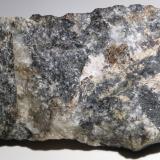 Tugtupite, Pyrochlore, Neptunite
Ilímaussaq Intrusive Complex, Narsaq, Greenland
9 x 4 x 2 cm
(irradiated with SWUV before the shot)
Focus on relevant area and comments to Neptunite and Pyrochlore on the next pic. (Author: kakov)
Tugtupite, Pyrochlore, Neptunite
Ilímaussaq Intrusive Complex, Narsaq, Greenland
9 x 4 x 2 cm
(irradiated with SWUV before the shot)
Focus on relevant area and comments to Neptunite and Pyrochlore on the next pic. (Author: kakov)
Tugtupite, Pyrochlore, Neptunite I
-
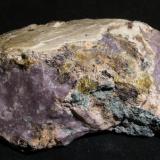 Ussingite, Vuonnemite, Sphalerite
7 x 4,5 x 3 cm
Lovozero Massive, Kola Peninsula, Russia
Probably from the Shkatulka pegmatite - to be confirmed.
The purple material is the Ussingite; they yellow plate on the top is Vuonnemite, Sphalerite is seen as bright yellow grains in the Ussingite. The small black dots might be Steenstrupine-(Ce), that is much less common in the Kola intrusions than in Ilímaussaq. (Author: kakov)
Ussingite, Vuonnemite, Sphalerite
7 x 4,5 x 3 cm
Lovozero Massive, Kola Peninsula, Russia
Probably from the Shkatulka pegmatite - to be confirmed.
The purple material is the Ussingite; they yellow plate on the top is Vuonnemite, Sphalerite is seen as bright yellow grains in the Ussingite. The small black dots might be Steenstrupine-(Ce), that is much less common in the Kola intrusions than in Ilímaussaq. (Author: kakov)
Ussingite, Vuonnemite, Sphalerite

Access to FMF Forum
A general guide for using the FMF Gallery
